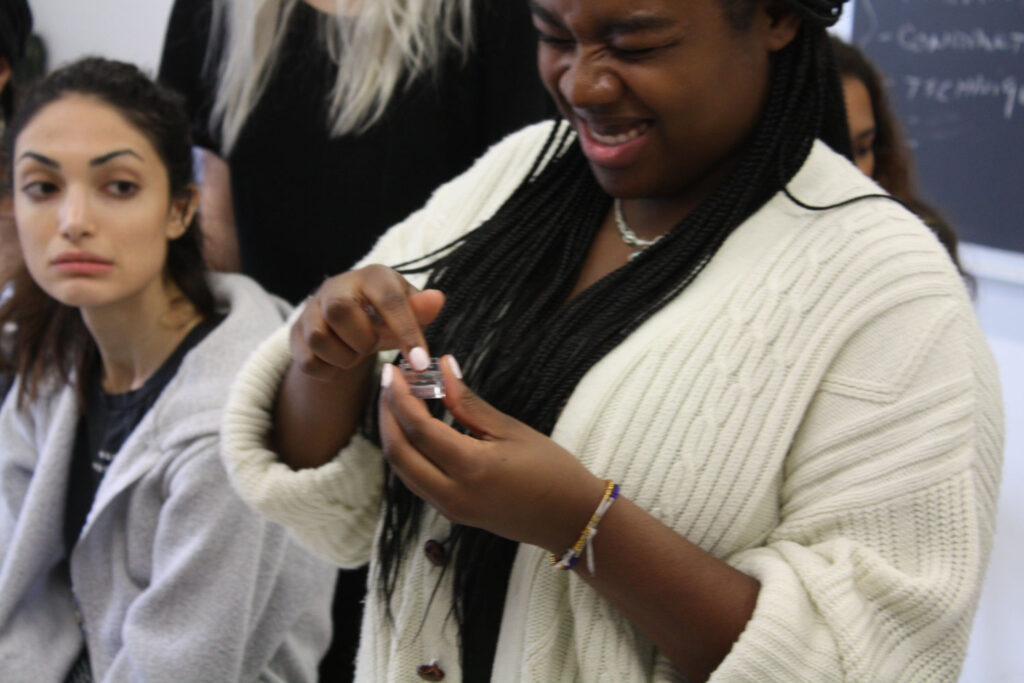Using the slab roller, extruder, coil, pinch, or wheel, make a sequence of modular forms that explore surface variables through touch as well as sight. Consider the gestalt of texture, form, structure, rhythm, material variation and physical interaction.
- Create a series of modular forms which fit together as a series forming a greater whole from the individual parts. Example concepts of modularity include: Stacking, Nesting, Tiling, Tessellation, Intersection, Interlocking, Piercing, Layering, Leaning, etc.
- Create clay test tiles and crucibles to explore textures, underglazes, glazes and inclusions
- Haptic, pay particular attention to creating variations in texture in all of your work for this project. We will be doing a blind review of the work, using our hands to “touch” and “feel” our way through each other’s work.






Actions + Deliverables
- Research and Ideation:
Research activities enable us to appraise and analyze existing design strategies, philosophies and contexts before embarking on a design process. An expected outcome may include multiple iterative conceptual and visual ideas expressed through sketches, peer examples and historical precedents, and visual as well as material research. - Multiple Concept Sketches
- Visual inspiration of texture, pattern and form, etc.
- Design research addressing the who (audience), what (content), how (interaction), where, when (context), and why (concept).
- Mood board(s)
- Creative Brief: Design proposals are developed through sketch drawing, ad-hoc modelling, and a written proposal that articulates the prosaic and/or poetic context of an opportunity for a designed response.
- Prepare a 1–2 page typed creative brief, with accompanying 2D and 3D Sketches, and supporting research deliverables.
- Materials, Methods, and Models: Explore various materials and forming methods to create initial models: e.g. plaster forming, slip casting, slump or drape molding, hand-building, wheel forming, glaze and clay testing, slip coloring, marbling, agateware, slip trailing, sprig applique, glaze and surface testing, plaster, lathe, wood, tar paper, 3D printing, fabric and paper flats, etc.
- Multiple material, method and model explorations of form, function, context, and production, responding to your creative brief and research.
- Material tests, including clay, glaze and surface testing, as well as explorations of ceramic in combination with secondary materials, eg. fiber, metal, wood, etc.
- Prototype: Create a set of shared and/or paired table wares that may accommodate the preparation, presentation and consumption of a meal.
- Greenware prototypes
- Bisqueware
- Glazed wares and post fire finishes
- Reflection, Project Documentation and Presentation: Photograph, film, draw, and document your research, process, and the use of these wares in a shared meal. Compose your documentation in a dynamic portfolio that may take the form of a project book, posters, videos, sketchbook, etc.
Prepare, and present your creative brief, research, mood board(s), models, prototypes, and documentation in class presentations to your peers, faculty, and visiting artists, designs and makers. - Sketches, drawings, models and prototypes
- Photographs and documentation of prototypes
- Creative Brief summary
- Research Summary
- Mood board
- Production methods used, glaze and material testing, etc.
- Reflections, written assessment of the pros, cons and pivots encountered during this project.
- In class presentation and discussion.
The project with all deliverables is due during the final review
Note that there are multiple interim deliverables with separate assignments that will be due throughout the semester.
Learning Outcomes
By the successful completion of this project, students will be able to:
- Demonstrate UNDERSTANDING of multiple forming methods for and properties of ceramic materials
- Demonstrate STRENGTH in the rapid creation and exploration of three-dimensional form in concept development
- Demonstrate STRENGTH in managing a complex project involving multiple overlapping tasks
- Demonstrate a STRONG, personal, iterative process for developing ceramic prototypes that employ design research and consider production methods, functional viability and fiscal considerations.
- Demonstrate UNDERSTANDING of surface application skills and develop a palette of glazes, slips and/or other surface treatments.
- Demonstrate STRENGTH in the presentation of a prototype with supporting documentation
- STRENGTH in their reflection on creative skills learned, choices made, and connections fostered between learning initiatives throughout the semester.
Related Assessable Tasks
- Weekly process documentation, including iterative sketches and models informed by research. This documentation may be presented in desk critiques or group pin-up reviews.
- Material Research that are sourced from manufacturers, vendors. Glaze, clay body and material testing.
- Creative Brief proposal for project.
- Prototype that illustrates the role of making in the design process and exhibits features established through iterative design, research, testing, and analysis.
- Presentations demonstrating an advanced ability to articulate an argument for design from opportunity through execution.
- Project Documentation culminated in a documentation that chronicles the identification of a design opportunity, development of a creative brief, experimental method and material research, aesthetic and conceptual research, establishment of design criteria, process notes and photographs, drawings, models and iterative design deliverables culminating in an addendum containing reflections and self-assessment.
Related Examples
- Julia SchusterLinks to an external site.
- Giles Miller StudioLinks to an external site.
- Eliza Mikus’ Contrast TilesLinks to an external site.
- Tessellated Wall Installations byJackie HeadLinks to an external site.


